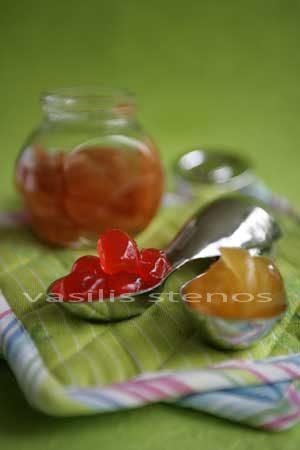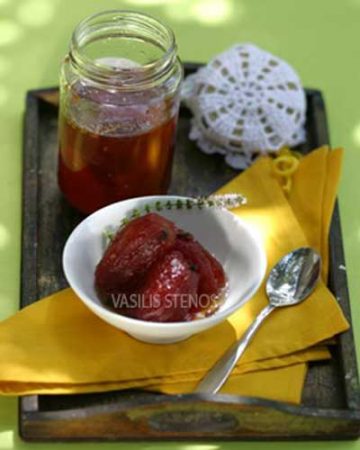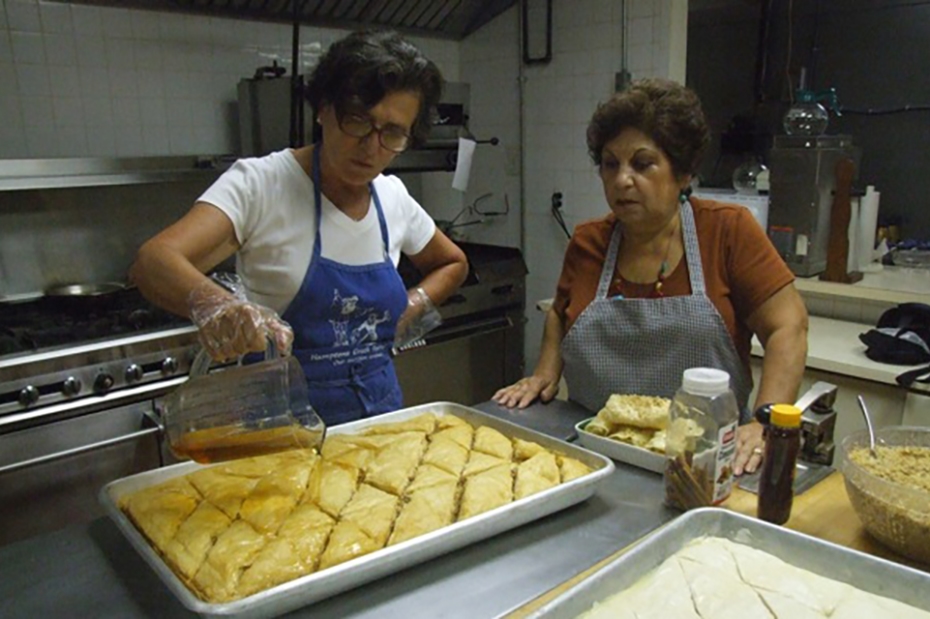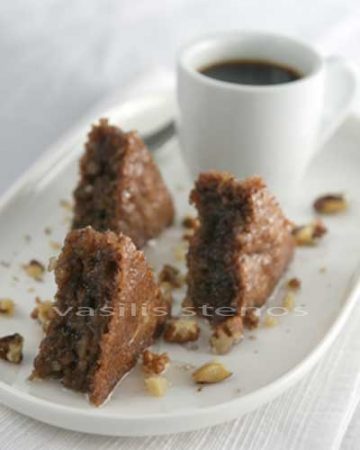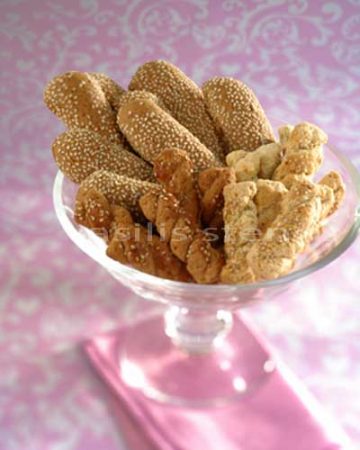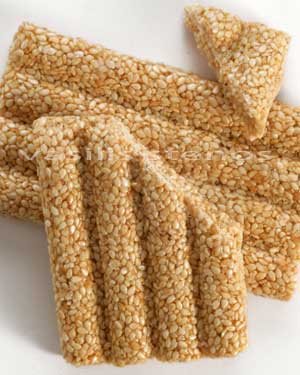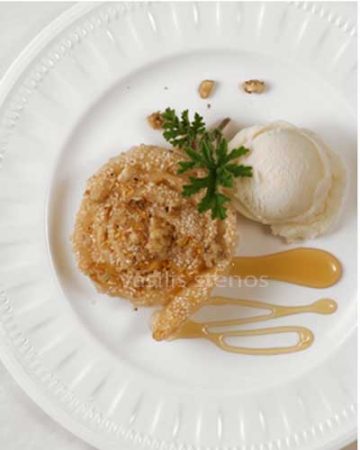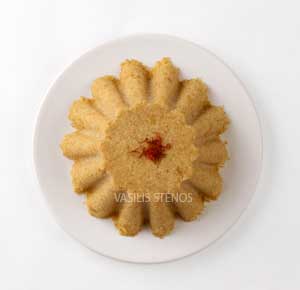SWEETS IN THE GREEK KITCHEN
Seasonal fruit is the dessert of choice among traditional Greeks, a custom maintained to this day both at home and in tavernas. But the Greek sweet repertoire is nonetheless large and diverse. Generally they fall into several categories: spoon sweets; whole-pan baked sweets; creams; fried and honey-drizzled sweets; cookies and biscuits; confections.
I. Spoon Sweets—Glyka tou Koutaliou
It used to be that every home cook worth her salt was adept at putting up fruit in syrup. The spoon sweets of Greece, lovely concoctions that are prepared according to the bounty of every season, are by far one of the country’s longstanding traditions.
Spoon sweets—so called because they are served on small plates and eaten with a small spoon and a glass of cool water—require skill and attention to detail in order to prepare well. Every fruit behaves differently when heated and submerged in syrup, and no doubt some spoon sweets are much more difficult and time-consuming to prepare. Today, their preparation is an art all but lost among modern home cooks. The task of making them has been assumed by large food companies, but luckily in recent years several very good artisans have begun to make and sell these sweets on a small scale.
As mentioned above, they follow the seasons. Here is a brief list of seasonal spoon sweets. Of course, since they are preserved in syrup, spoon sweets keep well and can be eaten all year round.
Spring:
Karydaki, Walnut spoon sweet, made with immature, green walnuts
Fystiki, Pistachio spoon sweet, made with immature pistachios. A specialty
of Aegina
Syko, Fig spoon sweet; this is one of several versions, made in the spring with
small, green, immature figs
Summer:
Rodopetalo, Rose Petal spoon sweet, a specialty of Chios and the Peloponessos
Karpouzi, Watermelon rind preserved in syrup (made with young melons)
Vyssino, sour cherry spoon sweet
Kerasi, cherry spoon sweet
Verykoko, apricot spoon sweet
Tomataki, small tomatoes preserved in syrup
Late Summer
Stafyli, grape spoon sweet, a specialty of Crete
Stafyda, raisin spoon sweet, a specialty of Crete
Melitzanaki, small eggplants preserved in syrup
Syko, dried figs in syrup
Fall
Kydoni, Quince spoon sweet, considered one of the finest
Firiki, small apples, a specialty of Mt. Pelion
Winter
Neratzi, young still-green, bitter oranges, preserved whole or at a later stage,
when ripened, in which case only the rind is preserved
Portokali, Orange rind spoon sweet
Pergamondo, Bergamot, a kind of citrus fruit
II. Whole-Pan Sweets (tou tapsiou)
This category of sweets includes almost anything baked and later drenched in syrup. Among the best-known such sweets are:
Baklava (layered phyllo and nuts, with sugar syrup or honey syrup)
Galaktoboureko (custard-filled phyllo pie)
Kataifi (shredded wheat, nut-filled pastry)
Revani (Syrup-soaked semolina cake)
Karythopita (Syrup-soaked walnut cake)
III. Biscuits and Cookies
Greek eat lots of different kind of biscuits and cookies. Among them:
Voutimata. These might be translated as “dunking” biscuits. They generally are not all that sweet and are taken with morning coffee, hence their name.
Koulourakia. These are butter-based cookies in various shapes and flavoured with everything and anything from orange juice to brandy and/ or ouzo, to spices such as cumin. There are also special Easter koulourakia, shaped into twists, coils, etc.
Melomakarona. One of the classic Greek winter holiday cookies, made with flour and walnuts, then, once baked, dipped in honey syrup.
Kourambiedes. Another classic on the Christmas and New Year’s tables. These are basically shortbread cookies rich in almonds and dusted with confectioner’s sugar.
IV. Creams
There are several well know dessert creams, among them:
Rizogalo, or rice pudding
Moustalevria, an unusual, seasonal preparation made by simmering grape
must and flour
V. Confections
Pastelli. When Greece produced tons of sesame, pastelli was made all over the country. Now, most sesame is imported but the confection, basically made with sesame seeds (or sometimes with nuts) set in honey like a brittle, is still a classic.
Soutzouk Loukoum. This is an interesting confection from the north of Greece made by stringing walnuts and dipping them in moustalevria or in a sweet mixture based on cornstarch until the walnuts are totally coated and the resulting sweet resembles a sausage.
Amygdalota. This is the name for almond confection in Greek, a general term which can include many different, regional recipes. Usually these are made with blanched almond paste and shaped into pears, balls or small logs. Sometimes they are baked. Almost always, though, they are covered with confectioner’s sugar.
Vanillia or Mastiha. Sugar pastes flavoured either with vanilla or with mastic that are dipped into a glass of ice water and sucked off the spoon.
VΙ. Fried Sweets
Fried Sweets in the Greek dessert repertoire usually refers to some kind of pastry, either filled or like a fritter. Among the popular such sweets are:
Thiples, dough fritters drizzled with honey and nuts
Loukoumathes, fried dough puffs doused with honey and sprinkled with cinnamon
Sfiggoi, another kind of dough puff, akin to the French beignets.
HALVAH
Like the dolma and baklava, halvah is one of those dishes found
from the Balkans to India and claimed as its own by every culture
and country in between.
For Greeks, halvah is often one of the main sweets of Lent, but it is also
eaten all year round.
In Greece, there are several versions.
Farsala, near Volos, is famous for its smooth-textured halvah
known either as Sapoune (sa-poo-nai) or as Halva Farsalon. It is made with
rice flour or cornstarch and is opaque and unctuous with a crisp tasty topping
of burnt sugar.
Halva tis Rinas is a semolina-based halva made in a saucepan.
Makedonikos Halvas is the common tahini-based block savored with lemon
juice and retsina.

